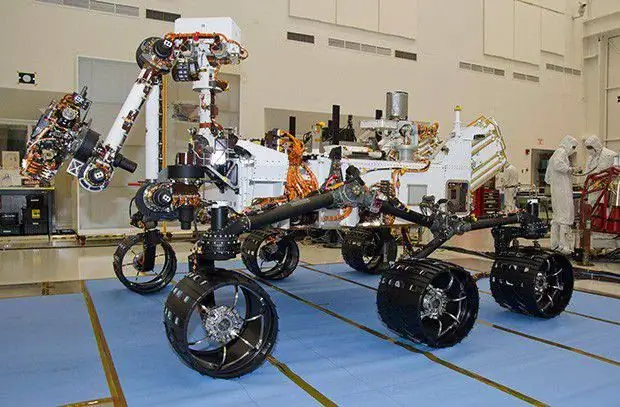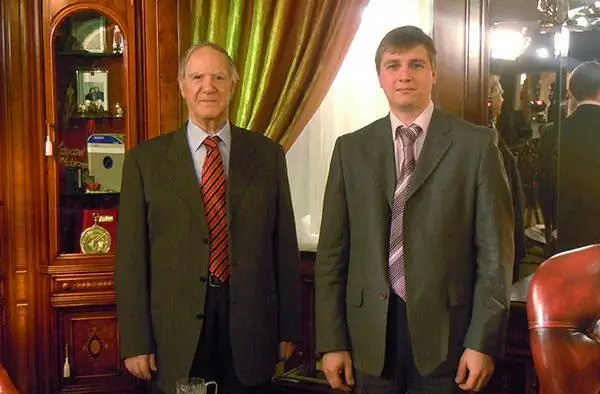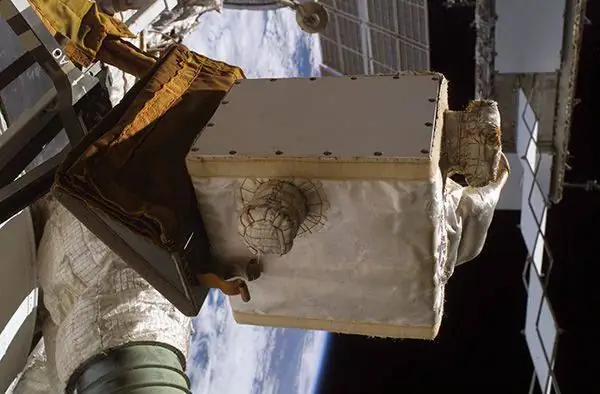- Author Matthew Elmers [email protected].
- Public 2023-12-16 21:49.
- Last modified 2025-06-01 06:23.

The discovery of water on Mars and the Moon by European and American probes is primarily a merit of Russian scientists
With regular reports of more and more new findings made by European and American missions, it escapes the public's attention that many of these discoveries were made thanks to the work of Russian scientists, engineers and designers. Among such discoveries, one can especially highlight the detection of traces of water on the closest to us and, as it previously seemed, completely dry celestial bodies - the Moon and Mars. It was Russian neutron detectors, working on foreign devices, that helped to find water here, and in the future they will help to provide for manned expeditions. Maksim Mokrousov, Head of the Laboratory of Nuclear Physics Devices at the Institute of Space Research (IKI), Russian Academy of Sciences, told the Russian Planet why Western space agencies prefer Russian neutron detectors.
- Spacecraft - orbiting, landing, and rovers - carry whole sets of instruments: spectrometers, altimeters, gas chromatographs, etc. Why are neutron detectors on many of them Russian? What is the reason for this?
- This is due to the victory of our projects at open tenders, which are carried out by the organizers of such missions. Like our competitors, we submit an offer and try to prove that our device is optimal for the given device. And now several times we have successfully succeeded.
Our usual rival in such competitions is Los Alamos National Laboratory, the same one where the Manhattan Project was implemented and the first atomic bomb was created. But, for example, our laboratory was specially invited to make a neutron detector for the MSL (Curiosity) rover, having learned about the new technology that we have. DAN, created for the American rover, became the first neutron detector with active particle generation. It actually consists of two parts - the detector itself and the generator, in which electrons accelerated to very high speeds hit the tritium target and, in fact, a full-fledged, albeit miniature, thermonuclear reaction with the release of neutrons occurs.
The Americans do not know how to make such generators, but it was created by our colleagues from the Moscow Research Institute of Automation named after Dukhov. In Soviet times, it was a key center where fuses for nuclear warheads were developed, and today part of its products are for civilian, commercial purposes. In general, such detectors with generators are used, for example, in the exploration of oil reserves - this technology is called neutron logging. We just took this approach and used it for the rover; until now no one has done this.
Active neutron detector DAN
Usage: Mars Science Laboratory / Curiosity (NASA) rover, 2012 to present. Weight: 2.1 kg (neutron detector), 2.6 kg (neutron generator). Power consumption: 4.5 W (detector), 13 W (generator). Main results: detection of bound water in the ground at a depth of 1 m along the route of the rover.
Maxim Mokrousov: “Along almost the entire 10-kilometer path traversed by the rover, the water in the upper layers of the soil was usually found 2-5%. However, in May of this year, he stumbled upon an area in which either there is much more water or some unusual chemicals are present. The rover was deployed and returned to a suspicious location. As a result, it turned out that the soil there is really unusual for Mars and consists mainly of silicon oxide."
- With generation, everything is roughly clear. And how does the neutron detection itself take place?
- We detect low-energy neutrons with proportional counters based on helium-3 - they work in DAN, LEND, MGNS and all our other devices. A neutron trapped in helium-3 "breaks up" its core into two particles, which are then accelerated in a magnetic field, creating an avalanche reaction and, at the exit, a current pulse (electrons).

Maxim Mokrousov and Sergey Kapitsa. Photo: From personal archive
High-energy neutrons are detected in a scintillator by the flashes they create when they hit it - usually organic plastic such as stilbene. Well, gamma rays can detect crystals based on lanthanum and bromine. At the same time, even more efficient crystals based on cerium and bromine have appeared recently, we use them in one of our most recent detectors, in the one that will fly to Mercury next year.
- And yet why are Western spectrographs chosen in exactly the same open competitions of Western space agencies, other instruments are also Western, and neutron detectors are Russian time and again?
- By and large, it's all about nuclear physics: in this area, we still remain one of the leading countries in the world. It's not only about weapons, but also about the mass of related technologies that our scientists are engaged in. Even during the Soviet era, we managed to achieve such a good groundwork here that even in the 1990s it was not possible to lose everything completely, but today we are again increasing the pace.
It should be understood that the Western agencies themselves do not pay a dime for these our devices. All of them are made for the money of Roscosmos, as our contribution to foreign missions. In exchange for this, we receive a high status of participants in international space exploration projects, and in addition, priority direct access to scientific data that our instruments collect.
We transmit these results after processing, therefore, we are rightfully considered the co-authors of all the findings that were made thanks to our devices. Therefore, all the high-profile events with the detection of the presence of water on Mars and the Moon are, if not entirely, then in many respects our result.
We can once again recall one of our first detectors, HEND, which is still operating on board the American Mars Odyssey probe. It was thanks to him that a map of the hydrogen content in the surface layers of the Red Planet was first compiled.
HEND neutron spectrometer
Usage: Mars Odyssey (NASA) spacecraft, 2001 to present. Weight: 3, 7 kg. Power consumption: 5.7 W. Main results: high-latitude maps of water ice distribution in the north and south of Mars with a resolution of about 300 km, observation of seasonal changes in the circumpolar caps.
Maxim Mokrousov: “Without false modesty, I can say that on Mars Odyssey, which will soon be in orbit for 15 years, almost all instruments have already begun to malfunction, and only ours continues to work without problems. It works in tandem with a gamma detector, effectively representing a single instrument with it, covering a wide range of particle energies."
- Since we are talking about the results, what kind of scientific tasks are performed by such devices?
- Neutrons are the particles most sensitive to hydrogen, and if its atoms are present anywhere in the soil, neutrons are effectively inhibited by their nuclei. On the Moon or Mars, they can be created by galactic cosmic rays or emitted by a special neutron gun, and we actually measure the neutrons reflected by the soil: the fewer there are, the more hydrogen.
Well, hydrogen, in turn, is most likely water, either in a relatively pure frozen form, or bound in the composition of hydrated minerals. The chain is simple: neutrons - hydrogen - water, so the main task of our neutron detectors is precisely the search for water reserves.
We are practical people, and all this work is done for future manned missions to the same Moon or Mars, for their development. If you land on them, then water, of course, is the most significant resource that will need to be either delivered or extracted locally. Electricity can be obtained from solar panels or nuclear sources. It is more difficult with water: for example, the main cargo that cargo ships have to deliver to the ISS today is water. Each time they take it 2-2.5 tons.
LEND neutron detector
Usage: Lunar Reconnaissance Orbiter (NASA) spacecraft, 2009 to present. Weight: 26.3 kg. Power Consumption: 13W Main results: discovery of potential water reserves at the South Pole of the Moon; construction of a global map of the Moon's neutron radiation with a spatial resolution of 5-10 km.
Maxim Mokrousov: “In LEND we have already used a collimator based on boron-10 and polyethylene, which blocks neutrons on the sides of the field of view of the device. It more than doubled the mass of the detector, but it made it possible to achieve greater resolution when observing the lunar surface - I think this was the main advantage of the device, which allowed us to bypass our colleagues from Los Alamos again."
- How many such devices have already been made? And how much is planned?
- They are easy to list: they are already operating HAND on the Mars Odyssey and LEND on the lunar LRO, DAN on the Curiosity rover, as well as BTN-M1 installed on the ISS. It is worth adding to this the NS-HEND detector, which became part of the Russian probe "Phobos-Grunt" and, unfortunately, was lost along with it. Now, at different stages of readiness, we have four more such devices.

BTN-M1. Photo: Space Research Institute RAS
The first of them - next summer - will fly the FREND detector, it will become part of the joint mission with the EU ExoMars. This mission is very large-scale, it will include an orbiter, a lander, and a small rover, which will be launched separately during 2016-2018. FREND will be working on an orbiting probe, and on it we use the same collimator as on the lunar LEND to measure the water content on Mars with the same accuracy with which it was done for the Moon. In the meantime, we have these data for Mars only in a rather rough approximation.
The Mercury gamma and neutron spectrometer (MGNS), which will operate on the BepiColombo probe, has long been ready and handed over to our European partners. It is planned that the launch will take place in 2017, while the last thermal vacuum tests of the instrument are already underway as part of the spacecraft.
We are also preparing instruments for Russian missions - these are two ADRON detectors, which will operate as part of the Luna-Glob descent vehicles, and then Luna-Resurs. In addition, the BTN-M2 detector is in operation. It will not only conduct observations on board the ISS, but will also make it possible to work out various methods and materials for effective protection of astronauts from the neutron component of cosmic radiation.
BTN-M1 neutron detector
Usage: International Space Station (Roscosmos, NASA, ESA, JAXA, etc.), since 2007. Weight: 9.8 kg. Power Consumption: 12.3W The main results: maps of neutron fluxes in the vicinity of the ISS were constructed, the radiation situation at the station was assessed in connection with the activity of the Sun, an experiment was being conducted to register cosmic gamma-ray bursts.
Maxim Mokrousov: “Having engaged in this project, we were quite surprised: after all, in fact, different forms of radiation are different particles, including electrons, and protons, and neutrons. At the same time, it turned out that the neutron component of the radiation hazard has not yet been measured properly, and this is a particularly dangerous form of it, because neutrons are extremely difficult to screen using conventional methods."
- To what extent can these devices themselves be called Russian? Is the share of elements and parts of domestic production high in them?
- Full-fledged mechanical production has been established here, at the IKI RAS. We also have all the necessary test facilities: a shock stand, a vibration stand, a thermal vacuum chamber, and a chamber for testing for electromagnetic compatibility … In fact, we only need third-party production for individual components - for example, printed circuit boards. Partners from the Research Institute of Electronic and Computer Engineering (NIITSEVT) and a number of commercial enterprises help us with this.
Previously, of course, our instruments had a lot, about 80%, of imported components. However, now the new devices we produce are almost completely assembled from domestic components. I think that in the near future there will be no more than 25% of imports in them, and in the future we will be able to depend even less on foreign partners.
I can say that domestic microelectronics has made a leap forward in recent years. Eight years ago, in our country, electronic boards suitable for our tasks were not produced at all. Now there are the Zelenograd enterprises "Angstrem", "Elvis" and "Milandr", there is the Voronezh NIIET - the choice is sufficient. It became easier for us to breathe.
The most offensive thing is the absolute dependence on the manufacturers of scintillator crystals for our detectors. As far as I know, attempts are being made to grow them in one of the institutes of Chernogolovka near Moscow, but they have not yet succeeded in achieving the required dimensions and volumes of an ultrapure crystal. Therefore, in this regard, we still have to rely on European partners, more precisely, on the Saint-Gobain concern. However, in this market the concern is a complete monopolist, therefore the whole world remains in a dependent position.






